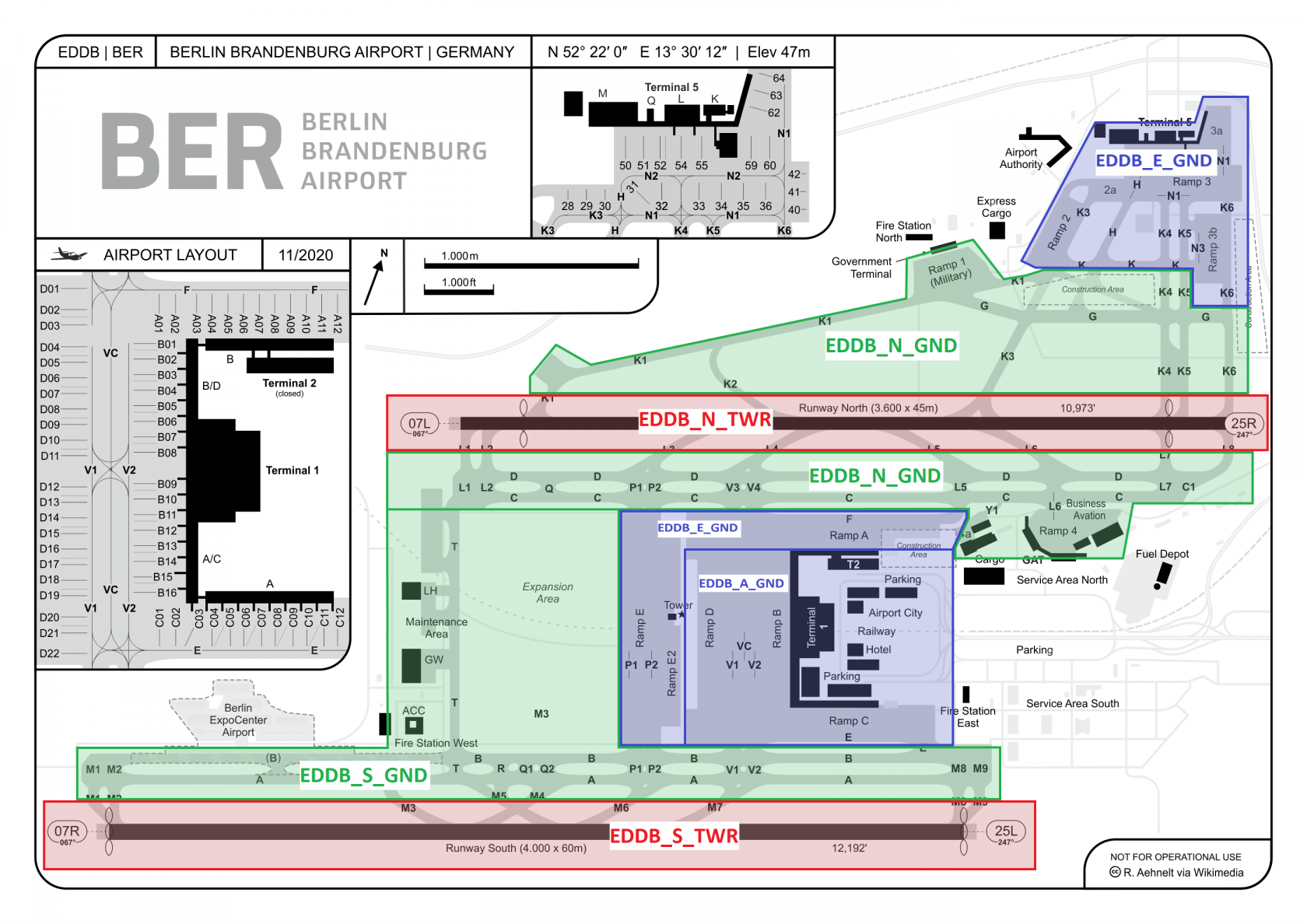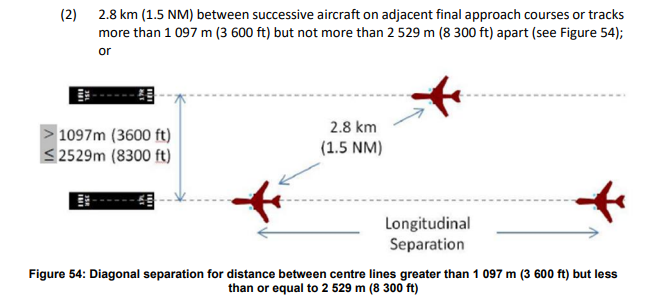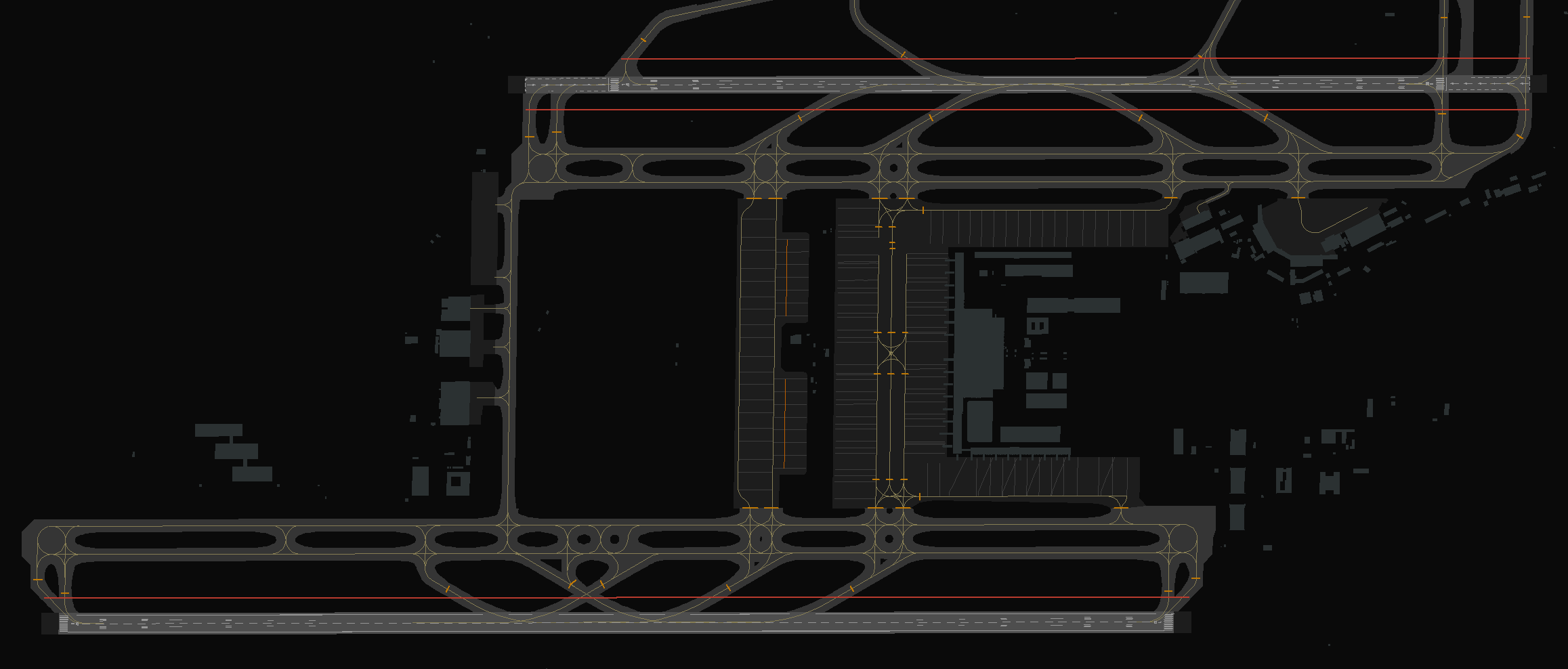Tower
Stations and AoRs
| Station |
Station ID |
Frequency |
Login |
| Berlin Tower Nord |
DBTN | 120.030 |
EDDB_N_TWR |
| Berlin Tower Süd | DBTS | 118.805 | EDDB_S_TWR |
If both Tower are online, the CTR is divided into two AoRs with a border between the runways. In case Ground is offline, Tower will cover this station.
General
Modes of operation
Berlin Airport is authorized for the following modes of operations:
| Mode |
Spacing between 06L/24R and 06R/24L |
| Alternating Approaches | 2,5 NM (*) |
| Dependent Parallel Approaches | 1,5 NM |
| Independent Parallel Approaches | --- |
| Independent Parallel Departures | --- |
| Dedicated Runway Operations (DROps) | --- |
(*) Alternating approaches will be used whenever dependent parallel approaches cannot be used (e.g. non-precision approaches).
Dependent Parallel Approaches
Dependent Parallel Approaches may be used whenever both aircraft perform a precision approach.
REQUIREMENTS AND PROCEDURES FOR DEPENDENT PARALLEL APPROACHES
- the final approach course or track is intercepted by use of:
- vectoring; or
- a published arrival and approach procedure that intercepts with the IAF or the IF.
- the instrument flight procedure that aligns the aircraft with the extended runway centre line is a precision approach
- aircraft are advised that approaches are in use to both runways;
- a minimum of nominal 1000 ft vertical separation or a minimum of 3.0 NM horizontal separation is provided between aircraft until established on the final approach courses or tracks of parallel approaches
- the minimum horizontal separation to be provided between aircraft established on the same final approach course or track is 3.0 NM unless increased longitudinal separation is required due to wake turbulence;
- the minimum horizontal separation to be provided diagonally between successive aircraft on adjacent final approach courses or tracks is:
Source: Regulation (EU) 2017/373, ANNEX IV — Part-ATS
Independent Parallel Approaches
During periods of high traffic, independent parallel approaches may be used.
REQUIREMENTS AND PROCEDURES FOR INDEPENDENT PARALLEL APPROACHES
The main responsibility of Berlin Tower is to monitor the approach area between 14 NM and the threshold. In case of any deviation from the LOC, the traffic on the adjacent LOC shall be turned immediately!
"Turn left/right(number) degrees/heading(three figures) immediately to avoid traffic *deviating from adjacent approach*, climb(level)."
In order to perform independent parallel approaches, both director and tower positions have to be staffed.
During Independent Parallel Approaches, both Tower need to activate the NTZ between both runways.
SUSPENSION OF INDEPENDENT PARALLEL OPERATIONS DUE TO METEOROLOGICAL CONDITIONS:
The meteorological conditions to be considered include, but are not limited to, the following:
- wind shear;
- turbulence;
- downdrafts; and
- crosswind and significant meteorological conditions such as thunderstorms, which might otherwise increase deviations from the final approach course or track to the extent that safety may be impaired.
Independent Parallel Departures
Independent parallel departures shall always be used, except if the following requirements are not met:
REQUIREMENTS AND PROCEDURES FOR INDEPENDENT PARALLEL DEPARTURES
- Parallel runways may be used for independent instrument departures as follows:
- both runways are used for mixed arrivals and departures (mixed operation).
- Independent IFR departures should only be conducted from parallel runways when the conditions listed below are met:
- both aircraft are flying an RNAV or RNP instrument departure and
- ATS operational procedures ensure that the required track divergence is achieved.
- both runways are used for mixed arrivals and departures (mixed operation).
In case departing traffic deviates from the departure route, the responsible tower controller needs to create separation immediately.
Note: Vectored and visual departures are not approved for independent parallel departures
SUSPENSION OF INDEPENDENT PARALLEL OPERATIONS DUE TO METEOROLOGICAL CONDITIONS:
The meteorological conditions to be considered include, but are not limited to, the following:
- wind shear;
- turbulence;
- downdrafts; and
- crosswind and significant meteorological conditions such as thunderstorms, which might otherwise increase deviations from the final approach course or track to the extent that safety may be impaired.
Dedicated Runway Operations (DROps)
In Berlin, dedicated runway operations will be used during the following conditions:
- Low Visibility Procedures
- Suspension of Independent Parallel Departures (e.g. due to CB, wind shear, turbulence, downdrafts, strong crosswind)
- Special regulation of traffic flows (e.g. shuttle event)
For Berlin, the following runway configurations are preferred for dedicated runway operations:
- 06-Operations: 06L departures, 06R approaches
- 24-Operations: 24L departures, 24R approaches
When the RVR falls below 1000 m and/or the ceiling is at or below 300 ft and CAT II/III operations are expected, Berlin Tower shall use DROps and inform Berlin Ground about the beginning of the LVP preparation phase.
Target Spacing
The responsible approach controllers will use the following target spacings depending on the conditions:
| Conditions |
Target Spacing |
| Departures expected | 6 NM |
| No departures expected | 3 NM |
| Low Visibility Operations | 5 NM |
Note: Tower may ask the approach control to increase the target spacing in case traffic has to depart between approaching aircraft. Usually, the Berlin approach unit will take the situation of departing traffic on the ground into account.
As long as possible, Tower may use reduced runway separation to depart traffic between approaching traffic. Due to the mixed operations on both runways, Berlin Tower must use every gap sufficient for departing traffic.
Landing Clearance Line (LCL)
Due to mixed operations on both runways at EDDB, a landing clearance line is established 90 m from the runway's centerline to expedite landing and takeoff clearances. As soon as a landing aircraft has crossed the landing clearance line, a takeoff or landing clearance can be issued to any succeeding aircraft.
The landing clearance line can be used whenever the following conditions are met:
- The landing clearance line is visible on the ground radar display
- The braking action on the runway is not reduced significantly
- For Vatsim only SN, ST, PL, GR and GS are considered as a reduction of braking action
- The vacating aircraft does not exceed ICAO Code Letter E
- The vacating traffic does not stop until reaching the holding point
Departing traffic
General Departure Release
Departures do not have to be released by EDWW (Bremen Radar) unless:
- EDWW explicitly restricts departures by time, SID or until further notice
- Departures out of the non-operational runway config
- The first departure after a runway change
- The first departure after an unplanned missed approach
- After every departure route with the designator K, M or Z
Departure Separation
The following departure separation shall be used, except if wake turbulence separation is higher:
| Conditions |
Separation |
| Same SID following | 3 NM* |
| Different SID following | 3 NM |
* Note: In contrast to many other VATGER aerodromes, Berlin Tower may use 3 NM separation for same SIDs.
Handoff
Departing Traffic will be transferred to Berlin Departure when established on the SID. The following frequencies shall always be used if APP or DEP are staffed:
- Traffic departing runway 06L/24R: Bremen Radar - 120.340 (Departure Nord)
- Traffic departing runway 06R/24L: Bremen Radar - 120.630 (Departure Süd)
Intersection Departures
On the following intersections, Berlin Tower shall ask if traffic is in sight when using conditional clearances:
- Runway 06L: L3, L4, K2
- Runway 06R: M3, M5
- Runway 24R: L5, L6
- Runway 24L: M6, M7
Arriving traffic
Separation on final
- After the transfer of communications from Director, Tower is responsible for monitoring the separation between arriving aircraft. If necessary Tower shall also use methods to ensure separation on the final.
- When traffic is inside the EDDB D(CTR) (below 2500 ft), Berlin Tower may adjust the speeds of aircraft on final without prior coordination. If this is done, Tower is solely responsible for separation to traffic behind, on the same final.
Handoff
If Berlin Ground is staffed, traffic will switch to Ground automatically when vacated. This procedure shall be broadcast in the ATIS.
Missed Approaches
In case of a missed approach, the responsible Tower controller shall inform Berlin Departure North/South immediately. Traffic will be handed over to Berlin Departure after coordination. The next departure on the affected runway is always subject to release if not coordinated otherwise (Departure Release).
VFR traffic
Control zone
 CTR Berlin - © openflightmaps.org
CTR Berlin - © openflightmaps.org
VFR Procedures
- VFR movements preferred via runway 24R/06L
- Crossing of the airport as to be coordinated between both Tower controllers
EDAZ traffic
IFR traffic inbound to EDAZ will momentarily enter Berlin D(CTR). Bremen Radar shall inform Berlin Tower about every IFR arrival EDAZ latest on approach clearance. Bremen Radar is also responsible for informing Berlin Tower once this traffic has landed.
To ensure separation between departing traffic from EDDB and arriving IFR traffic from EDAZ, Berlin Tower shall:
- Instruct every IFR departure from runway 24L to climb at least 2000 feet per minute until passing 3000 ft ("Climb at 2000 feet per minute or greater until passing 3000 ft). This clearance can be assigned when issuing the take-off clearance. When in doubt, Berlin Tower should ask the pilot if he is able for this climb rate before issuing the line-up clearance.



